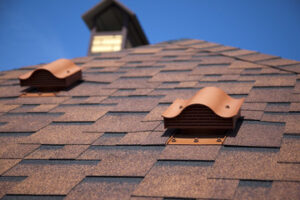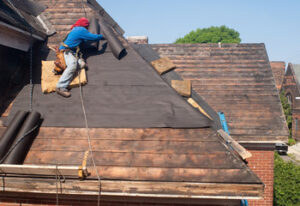In the winter, a roof venting system is essential to prevent ice dams from developing. This airflow removes warm attic air that would otherwise melt snow and ice and refreeze along the edges of the roof.
A proper attic ventilation system includes rafter vents in the spacing between rafters and a ridge vent along the roof peak. These components can be hidden behind finished walls, so they don’t spoil the look of your home. Professionals from Allen Roofing Company can help you with this.

Prevents Ice Damming
The big ice dams that build up on the edges of your roof can be very damaging, especially as they melt and thaw. They can tear off gutters, soffits, and even shingles. They also block the flow of water from the roof, which can cause serious damage to interior ceilings and walls. Luckily, you can prevent ice dams by ensuring your attic is properly ventilated and by installing proper insulation.
Poor attic ventilation leads to an imbalance of warm air in the attic and cooler outside air. The warmer air causes snow and ice to melt on the top of the roof, but it refreezes at the colder eave overhang. The resulting ice dams can be difficult and dangerous to break up.
To avoid ice dams, make sure your attic is well-ventilated by adding baffles or ridge vents to open up space. Proper attic insulation is another important step, as is upgrading to a minimum of R-40. Check the insulation level in your attic and install additional insulation as needed, as building codes require a minimum of 12 to 14 inches of fiberglass or cellulose.
Other factors that can lead to ice dams include the location of heating equipment in an attic, ductwork leaking warm air into the attic, and gaps around plumbing vents, wiring, recessed lights, and chimneys. A qualified contractor should evaluate these conditions and recommend a solution for your home.
Heated cables attached in a zigzag pattern along the eaves and gutters will help prevent ice dams by evenly warming your roof. These products are available at home improvement stores and are an inexpensive and effective way to prevent ice dams and the leaks that accompany them. They also offer a much safer alternative to breaking up ice dams by hand using a hammer or chisel, which can be hazardous. You can also prevent ice dams by opening up channels in the attic soffit or ridge vents with a crowbar and running hot water through the attic vents to heat your roof. This will prevent moisture from seeping into the attic and walls and causing mold and mildew.
Extends The Life Of Your Roof
You’re likely not thinking about the condition of your roof very often, but the reality is that proper roof ventilation has a major impact on your home and its longevity. It can affect your comfort, your energy costs, and even how much money you spend on home repairs down the line.
Poor ventilation can cause the temperature of your attic to rise to extreme levels during hot weather, heating your living spaces and causing air-conditioning to work overtime. This can lead to expensive cooling bills and premature shingle wear. In addition, a poorly vented attic can also create an environment that encourages the growth of mold and mildew in your home and is conducive to attracting unwanted pests such as insects and rodents.
Inadequate ventilation also causes ice dams and snow accumulation on the roof, which can loosen shingles, damage the eaves, and seep into your house, potentially causing serious water and structural damage. Proper attic ventilation keeps temperatures at reasonable levels throughout the year, preventing this type of damage and extending the life of your roofing materials.
The natural circulation of air in an attic is aided by the stack effect and wind, which means that the hotter air at the top of the attic will rise and exit through vents located at the ridge line. Cooler air will then enter the attic through vents in the soffit, and this creates a balanced system of intake and exhaust that naturally circulates air.
It’s important to keep in mind that there are different types of attic ventilation, and a professional roofer can help you determine the best solution for your attic space and needs. There are two main types of attic ventilation: Mechanical – This option uses electric fans to pull and release air. It is generally recommended to use a ridge vent with a high R-value, which can be nailed to the soffit or attic deck, and will protect against snow build-up and ice dams.
Having a well-ventilated attic can significantly extend the life of your roof, prevent ice damming and moss build-up, and reduce your utility bills. When you choose a roofer to install your new attic ventilation system, be sure they use a ridge vent with an R-value of over 40. This is an important feature for cold climates, as it helps to ensure that snow and ice do not block the exhaust opening of the ridge vent.
Prevents Mold And Mildew Growth
Mold and mildew thrive on moisture and food. They can be a nuisance and are known to contribute to some health problems, such as allergies and asthma. In addition, they can cause stains and rot to wood products, fabrics, and paper. Mold spores can also spread throughout a home, causing additional health problems for those in the house. Mold and mildew are not only unsightly, but they can also be toxic to humans and animals.
Mold growth can often be prevented by providing a dry environment. This can be done by ensuring that there is good airflow in the house and by reducing the amount of water around the home. To reduce the amount of moisture in the house, make sure to clean the gutters regularly, allowing them to drain properly. Also, ensure that all basements and crawl spaces are well-ventilated.
A dehumidifier can be used to remove excess humidity from the house. Also, by increasing the number of windows and opening doors between rooms, it is possible to increase airflow in the house.
In many areas, high indoor humidity levels are a normal part of summer. However, these levels should not be allowed to exceed 60 percent. When humidity is too high, condensation may form on walls and windows and lead to rot and mold growth.
Mildew and mold can also grow on a wide variety of household surfaces, including wallpaper, cardboard, carpets, drywall, fabric, plant materials, food, and insulation. They will usually develop within 24 to 48 hours after a surface becomes damp, and then produce spores that can spread throughout the house.
Mildew and mold can be prevented by keeping all fabric articles, such as clothing, shoes, bags, and blankets, as clean as possible. The soil on dirty articles provides a rich food source for mildew-causing molds, and greasy films can encourage mold growth as well. Clean all soiled fabric articles thoroughly, and allow them to air dry completely before using them again. If possible, allow nonwashable fabrics to air dry outdoors. Alternatively, use a moisture or humidity meter to determine the level of humidity in the home.
Prevents Water Damage
When water gets trapped in your attic due to inadequate roof ventilation, it can leak down onto your walls and ceilings. This moisture can cause mold, mildew, rot, and other forms of damage that can affect your entire home and even lead to structural problems with the foundation of your house. In the worst-case scenario, if this problem goes unaddressed for too long, it can result in major damage that could require a complete roof replacement and other costly repairs to your home or building.
In cold climates, improper roof ventilation can also lead to the formation of ice dams during winter. When heat from the interior of your home rises into the attic, it melts snow on the roof, which then refreezes when it reaches the cooler edges of the roof. This freeze-thaw cycle can create a dam that holds water back up against the shingles and can saturate the roof decking, soak the walls and fascia boards, and ruin interior and exterior paint. Ice dams can tear off gutters, soffits, and shingles; cause water to leak into the attic; and destroy ceilings and wall structures.
Lastly, proper roof ventilation prevents condensation that can be the source of other issues, including mold, mildew, and rot. It can help regulate the temperature of your attic space, making your home or building more comfortable and energy efficient.
The good news is, that you can solve most ventilation problems by having a professional install gable or ridge vents, eave vents, and soffit vents in your attic. These simple solutions will ensure that you have a functioning ventilation system and can protect your building and belongings from expensive damage.
Poor attic ventilation can cause all kinds of issues, from higher energy bills to premature deterioration of your roofing materials. In addition to causing these problems, it can also cause health and safety issues that will hurt the overall quality of your living or working environment. Fortunately, you can avoid all these problems by having a well-functioning roof ventilation system installed and maintained by an experienced professional.


